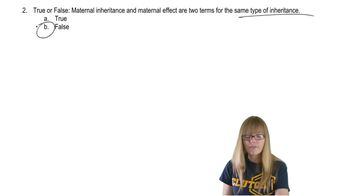Table of contents
- 1. Introduction to Genetics51m
- 2. Mendel's Laws of Inheritance3h 37m
- 3. Extensions to Mendelian Inheritance2h 41m
- 4. Genetic Mapping and Linkage2h 28m
- 5. Genetics of Bacteria and Viruses1h 21m
- 6. Chromosomal Variation1h 48m
- 7. DNA and Chromosome Structure56m
- 8. DNA Replication1h 10m
- 9. Mitosis and Meiosis1h 34m
- 10. Transcription1h 0m
- 11. Translation58m
- 12. Gene Regulation in Prokaryotes1h 19m
- 13. Gene Regulation in Eukaryotes44m
- 14. Genetic Control of Development44m
- 15. Genomes and Genomics1h 50m
- 16. Transposable Elements47m
- 17. Mutation, Repair, and Recombination1h 6m
- 18. Molecular Genetic Tools19m
- 19. Cancer Genetics29m
- 20. Quantitative Genetics1h 26m
- 21. Population Genetics50m
- 22. Evolutionary Genetics29m
17. Mutation, Repair, and Recombination
Types of Mutations
Problem 12c
Textbook Question
Textbook QuestionIf you were to look up Gaucher disease on the OMIM website, you would see that there are three major types, designated Type I (OMIM 230800), Type II (OMIM 230900), and Type III (OMIM 231000). All three types are mutations of the gene for acid-β-glucosidase, encoded on chromosome 1. Different mutations of this gene produce the three types of Gaucher disease that differ somewhat in their symptoms and disease severity.
For each mutation, speculate about whether the acid-β-glucosidase enzyme is merely reduced in function or whether its production is eliminated, and explain why.
 Verified Solution
Verified SolutionThis video solution was recommended by our tutors as helpful for the problem above
Video duration:
3mPlay a video:
Was this helpful?
Key Concepts
Here are the essential concepts you must grasp in order to answer the question correctly.
Gaucher Disease Types
Gaucher disease is a genetic disorder caused by mutations in the gene encoding acid-β-glucosidase, leading to three major types: Type I, Type II, and Type III. Each type is characterized by varying symptoms and severity, with Type I being the most common and least severe, while Type II is the most severe and often fatal in infancy. Understanding these distinctions is crucial for analyzing the functional impact of specific mutations on the enzyme.
Recommended video:
Guided course

Types of Maternal Inheritance
Acid-β-glucosidase Function
Acid-β-glucosidase is an enzyme responsible for breaking down glucocerebroside into glucose and ceramide. In Gaucher disease, mutations can lead to either a reduction in enzyme activity or complete loss of function. The degree of enzyme activity directly correlates with the severity of the disease, making it essential to assess whether mutations result in diminished function or total enzyme absence.
Recommended video:
Guided course

Functional Genomics
Genetic Mutations and Enzyme Activity
Genetic mutations can affect protein function in various ways, including missense mutations that alter amino acids, nonsense mutations that create premature stop codons, or frameshift mutations that disrupt the reading frame. These changes can lead to reduced enzyme activity or complete loss of production. Speculating on the nature of these mutations in Gaucher disease helps in understanding the clinical manifestations and potential treatment strategies.
Recommended video:
Guided course

Mutations and Phenotypes

 9:49m
9:49mWatch next
Master Point Mutations with a bite sized video explanation from Kylia Goodner
Start learning


